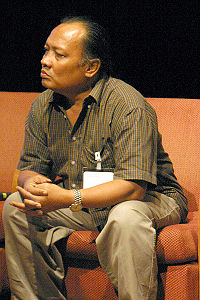I La Galigo
I La Galigo is music-theater work by Robert Wilson that has been shown since 2004 in Asia, Europe, Australia and the United States. It is based on an adaption by Rhoda Grauer of the epic creation myth Sureq Galigo of the Bugis from South Sulawesi, written between the 13th and 15th century in the Indonesian language Buginese.[1][2][3]
Plot summary


Out of the vast material in Sureq Galigo, that covers the story of a so-called Middle World (that of humanity), the drama focuses on one particular narrative thread, about the warrior Sawerigading, and his twin sister, We Tenriabeng.[2] They are descendants of the gods of the heavens and the gods of the underworld who send their offspring to inhabit the earth.[1] From the time in the womb of their mother, which is put onto stage, they are destined to fall in love with each other.[2] Worried that their incest would doom the world, the Bissu priests order them to be separated at birth. Sawerigading travels abroad but is eventually told about the world's most beautiful woman. He returns home and actually falls in love with his twin sister. To avoid the worst, We Tenriabeng introduces him to a woman of equal beauty, whom he marries to have a son named I La Galigo.[1] Nevertheless, the earth is cleansed of all life another time and their children mate again to repopulate it and start a new era.[2]
Production

While parts of the story are narrated, the actors are not speaking but expressing themselves through dance and gestures. The three-hour-long performance is accompanied extensively by light effects characteristic for Wilson's work and music by an onstage ensemble.[3] Their music sounds traditional, but has actually been composed for the production by the Javanese composer Rahayu Supanggah after intensive research in South Sulawesi.[2][4] For better dramatic expression, other Javanese and Balinese instruments were added to the initially five traditional Sulawesi instruments and new ones were made as well, amounting eventually to 70 instruments played by 12 musicians.[4]
Rehearsals for I La Galigo began in workshops at The Watermill Center on Long Island, New York.[5]
Cast

The production cast consists of 53 musicians and dancers, exclusively from Indonesia and mostly from Sulawesi, as well as one of the few remaining bissu, Puang Matoa Saidi from the Bugis community, who narrates parts of the story.[1][2]
International performances
| Date | City | Venue | Reviews |
|---|---|---|---|
| 12–13 March 2004 | Singapore | Esplanade - Theatres on the Bay | [1][6] |
| 12–15 May 2004 | Amsterdam | Het Muziektheater | [7] |
| 20–23 May 2004 | Barcelona | Teatro Lliure | |
| 30 May - 2 June 2004 | Madrid | Teatro Español | |
| 8–10 June 2004 | Lyon | Les Nuits de Fourvière | |
| 18–20 June 2004 | Ravenna | Teatro Alighieri | |
| 13–16 July 2005 | New York City | New York State Theater | [2][3][8] |
| 10–12 December 2005 | Jakarta | Teater Tanah Airku | [6] |
| 19–23 October 2006 | Melbourne | State Theatre | [9] |
| 12–17 February 2008 | Milan | Teatro degli Arcimboldi | [10] |
| 7–10 August 2008 | Taipei | Taipei Culture Center | |
| 23–24 April 2011 | Makassar | Fort Rotterdam | |
| 3–7 July 2019 | Jakarta | Ciputra Artpreneur |
Finally for the first time I La Galigo performance in their home town, in Makassar the capital city of South Sulawesi, Indonesia. I La Galigo back to home after 6 years performance around the world.
See also
- Coppong Daeng Rannu, a master of Makassar ethnic-group dances, best known as the Rice Goddess in I La Galigo
References
- ^ a b c d e Wayne Arnold (2004-04-07). "Robert Wilson Illuminates Indonesian Creation Myth". New York Times. Retrieved 2008-09-04.
- ^ a b c d e f g Edward Rothstein (2005-07-15). "A Sacred Epic and Its Gods, All Struggling to Survive". New York Times. Retrieved 2008-08-19.
- ^ a b c Helen Shaw (2005-07-15). "Micromanaging Indonesia". The New York Sun. Retrieved 2008-08-19.
- ^ a b Carla Bianpoen (2004-04-04). "Supanggah sets the tone in 'I La Galigo'". The Jakarta Post. Retrieved 2008-09-26. [dead link]
- ^ "Robert Wilson Illuminates Indonesian Creation Myth". The New York Times. 7 April 2004.
- ^ a b Jennifer Lindsay (2007). "Intercultural Expectations: I La Galigo in Singapore". The Drama Review. 51 (2): 60–75. doi:10.1162/dram.2007.51.2.60. S2CID 57562359.
- ^ Matthew Isaac Cohen (2005). "I La Galigo (review)". Asian Theatre Journal. 22 (1): 138–149. doi:10.1353/atj.2005.0002. S2CID 162218622.
- ^ Cordula Quint (2006). "I La Galigo (review)". Theatre Journal. 58 (2): 335–337. doi:10.1353/tj.2006.0129. S2CID 191961745.
- ^ Macknight, Campbell (2006). "I La Galigo: State Theatre, Melbourne International Arts Festival 19–23 October 2006". RIMA: Review of Indonesian and Malaysian Affairs. 40 (2): 141–148.
- ^ Giuseppe Distefano (2008-02-15). ""I La galigo" di Bob Wilson". Il Sole 24 ORE. Retrieved 2008-08-19.
